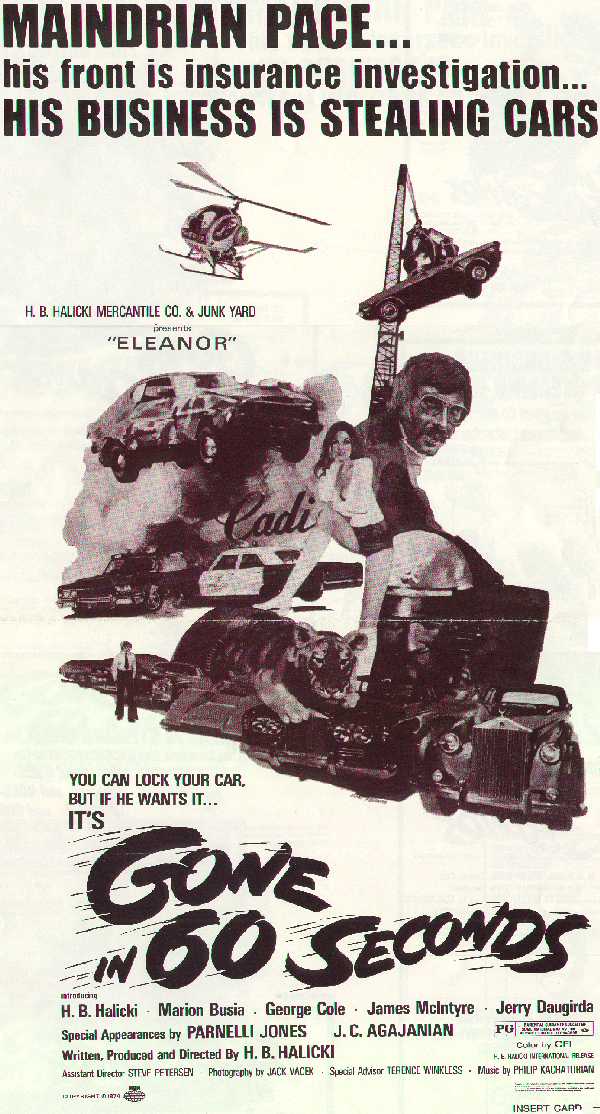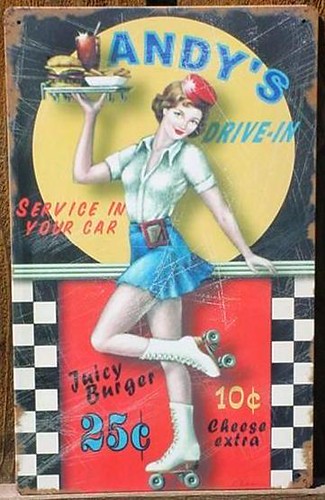GONE IN 60 SECONDS
By: Mike Marino
>
Car boosting was elevated to museum quality in the film, "Gone in 60 Seconds". Nick Cage and Angelina Jolie, along with a memorable cast, hot wired their way through the streets of Long Beach in southern California. Memphis Raines on a Holy Grail rampage of high speed grand theft auto action, in an effort to save his brother from the junkyard crusher, just more proof, that blood is indeed thicker than 10-W-40. But wait..there's still one more car to go. The one that even the great and holy Memphis Raines fears. The almighty automobile known as Eleanor.
Eleanor was a sexy, man eating, asphalt eating Motor City dream machine complete with phallic apparati and a sweet Jesus fuel injection system to give her the automotive equivalent of a high octane, high speed Detroit orgasm. In the Nick Cage version of "Gone in 60 Seconds", Eleanor was a Shelby Mustang GT500, but in the 1974 original, she was a 1973 Ford Mustang Mach I.

Flashback! Flashback! In the polyester year of 1974, there dwelt in the kingdom of the junkyard, a King. The King was surrounded by all manner of metal and junk, discards and throwaways, formerly loved, but now forgotten automobiles, piled high on a trashpile, unholy ground, about to be blessed by the prophet/king. The king's treasure chest grew full. Pieces of metal, a car door here, a hood ornament there, a side view smashed mirror over there amid the piles of aluminum scrap fascinating him as they glimmered as brightly as gold and silver in a chaotic treasure house. Then it came to him in a V-8 vision that only a junkyard junkie could conjure from the spiritual depths, to put the pieces of these old relics together and create a tribute to what they were in their glory days, the days when they just rolled off the assembly line, loud and proud. Their style, beauty and grace all but blinding, and what better venue than the celluloid pedestal where this monument could last a lifetime. It was at this moment of realization that H. B. Haliki wrote, produced, directed and starred in the original "Gone in 60 Seconds", which was released to drive in and indoor movie theaters across the country in 1974.
The original film had our protaganist on the prowl for just 46 cars and not 50 as in the remake, however, there were more chase scene mileage per hour than the Cage motion picture vehicle, and most importantly, the elegant Eleanor was a 1973 Ford Mustang Mach I and not the equally exotic Shelby Mustang GT500 of the remake. The flick was a hit with the asphalt crowd and they roared and cheered as H. B and Company reved and redlined their way across the cinematic landscape and when the closing credits rolled down the screen, the salivating roadheads eagerly anticipated the making of "Gone II" as though they were waiting for the chrome-magnon version of the Second Coming, and it wasn't too awefully long in coming. H. B. decided in 1989 that enough time had passed and the public was ready for Part II, but it was during filming and the performing of his own stunts that the man who gave life to "Gone"....was gone himself, in less than 60 seconds.

Cage/Jolie rock n roll, lock n load in "Gone: The Remake", and no, yes, Angelina's red hot pillow soft lips and gleam in the eye warm the heart and soul, but it's that damned Eleanor that makes the heart race faster and faster, jet propelling our erogenous zone to the outer limits of comfort. Her redlining engine on fire with petrol and passion. Her sleek, svelt body an alluring aluminum vehicular vessel of lust. Tail pipe searing hot to the touch, the leather seats exciting the senses, and turning asphalt into hot tar at a glance.
Eleanor Rules!
Memphis Raines is no match for the intoxicating Shelby Stang, and he knows it, better than anybody, and in the end, after a chase sequence that is not bad by any standard, he presents a limping, scratched and badly beaten up Eleanor to the obligatory bad guys who proclaim, "I asked for 50 cars and not 49 and a half". More chaos, more machismo, more punches, and eventually Memphis reigns supreme, good guy wins and all that stuff, and in the end not only gets to keys to Eleanor, but gets to hotwire Angelina as well.
Now, just who the hell is Carroll Shelby, and why are they naming cars after him?
Carroll Hall Shelby came out roaring down the quarter mile track of life in Texas in 1923, and after a stint in the Air Corp, that need for speed led him the the world of asphaltia, and in 1952 had raced his first quarter mile in a rod outfitted with a flathead Ford V-8. By 1961, Shelby teams up with a British auto manufacturer and after much Trans-Atlantic haggling, the culmination was the creation of the Shelby Roadster 260 that was brought to life in the Shelby facilities in southern California. The name comes to Shelby literally, in a dream, for his new dream machine, The Cobra. The car is test driven, and in April of 1962 makes it's first public appearance at the Auto Show in New York with the Ford display, and as a result, orders for the new monster defy imagination. The Cobra had struck a nerve. Soon, Shelby and Ford become synonomous, and by 1966 the first of the '67 Shelby Mustang GT350's and GT500's are produced. By 1969 the thrill is going, going, though not quite gone, and the Shelby project ends. The leftover '69s are upgraded to '70 specs and production finally ceases. The Ford-Shelby Era is now a thing of the past, but thanks to H. B.
Haliki there will always be a Motor City elegance known simply as the Marilyn Monroe of automobiles, Eleanor!



Classic Cars, Rock n' Roll, Elvis, Drivein Movies & Route 66! Kerouac, The Beats, Haight Ashbury, Easy Rider & Vietnam!

The Roadhead Chronicles goes from the Cold War Fifties Pop Culture of classic cars and rock n' roll to the spaced out Spare Change Sixties of Vietnam and Hells Angels. Not the usual look at the era, instead It's written by someone who lived it and spent a life of being on the road from his beach bum days in Honolulu to the glitz and dangers of the Sunset Strip in LA, and his purple hazed and double dazed days in North Beach and the Haight Ashbury in San Francisco.
The Roadhead Chronicles also looks at the history of Route 66, Roadside Neon Culture and old diners and dives!

Mike Marino writes in an offbeat and irreverant style with a beat and a cadence that is all his own.
His writing style has been compared to John Dos Passos, John Steinbeck and Terry Southern and one reviewer likened him to Frederick Lewis Allen on acid! Readers and critics call the book "wickedly wonderful", "delightfully weird" and "automotively
sexy.
"!!
